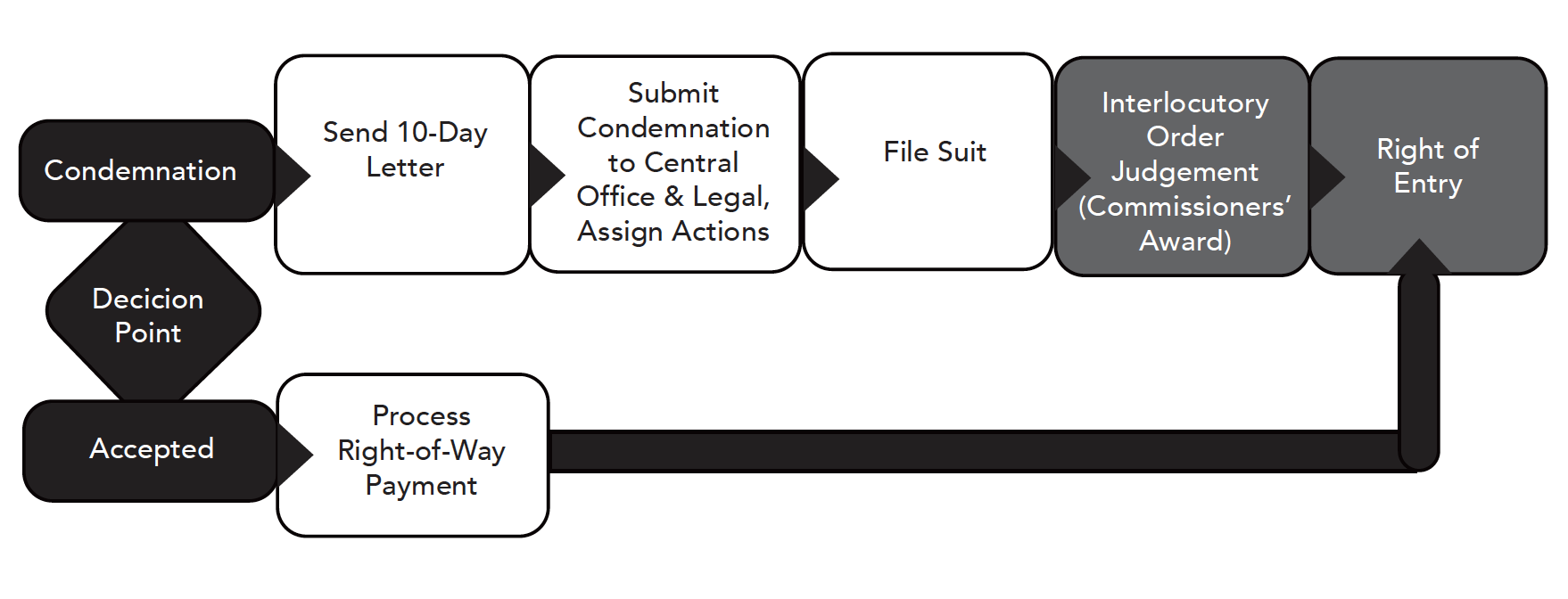Search for articles or browse our knowledge portal by topic.
Condemnation

If all reasonable attempts to negotiate for a property do not result in an agreement, the Cabinet will initiate a condemnation action. The Acquisition Branch Manager and their staff review the parcel(s) recommended for condemnation action. If they verify reasonable measures were taken to settle with the property owner and it is unlikely further negotiations would be productive, the Director of the Division of Right of Way and Utilities sends a written request to the Office of Legal Services recommending condemnation. Condemnation is also necessary whenever rightful ownership of the property or a partial property interest cannot be established.
The PM provides relevant plan sheets and descriptions for any parcel recommended for (or is in) condemnation as well as exhibits that may be needed during proceedings.
The negotiator must thoroughly explain to the property owner what steps are involved in the condemnation process. The negotiator needs to inform the property owner that they will receive the 10-day letter from the Cabinet, which affords them a chance to make another counteroffer if they so choose. At the end of this 10-day period, if the property owner has not responded or an agreement cannot be reached, KYTC sends another explaining that the condemnation action is moving forward. A Cabinet attorney should help draft the letter; the letter will explicitly state that further questions must be directed to KYTC’s attorney.
Parcels selected for condemnation are submitted to Acquisition Branch Manager and the District’s attorney by agents conducting the negotiations. If the District lacks an attorney, the parcel is submitted to the Acquisition Branch Manager so that an attorney may be assigned.
Condemnation actions do not always proceed to trial. They may be resolved through an administrative settlement, legal settlement (with recommendation by the Commonwealth’s attorney), or court-ordered mediation.
The Right of Way Guidance Manual (ROW 703-5) outlines the conditions under which an attorney can agree to a legal settlement. The attorney’s authority varies based on how much the legal settlement deviates from a parcel’s appraised value. If the deviation exceeds what the attorney is authorized to approve, the attorney provides a recommendation for settlement to the Director of Right of Way and Utilities. Only the Director has full settlement authority.
Lessees are made party to the suit unless the leasehold interest has been absolved. Uneconomic remnants (excess property) are excluded from condemnation suits.
Milestone
For KYTC to take possession of a condemned property, the circuit court shall have signed and entered an Interlocutory Order and Judgment (IOJ). Once an IOJ has been entered, the state posts with the circuit clerk the sum awarded to the property owner by a Commissioners’ Award, a court judgment, the amount of an agreed IOJ, or the amount of an agreed order settling the case. In some cases, the Commonwealth’s attorney will recommend settlement, but the Director of Right of Way and Utilities is the only one with full settlement authority. Checks issued as result of judgments taken in circuit court, jury verdicts, or settlements of condemnation actions are forwarded to the district attorney for distribution.
Milestone
For all condemnation actions the Commonwealth’s trial attorney must notify the appropriate district Right of Way Supervisor of the date right of entry is received. Rights of Entry can be accepted only for unoccupied parcels.
Time Management for Highway Project Development Knowledge Book:
Access the complete Knowledge Book here: Time Managment Knowledge Book
Next Article: Biological Assessment
Previous Article: Right of Way Acquisition


